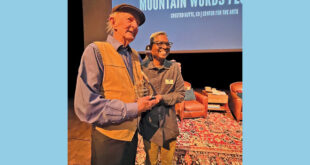It’s time to talk resiliency…
by lindsey freeburn
(Editor’s Note: Lindsey Freeburn has lived in the valley for nine years and has become increasingly involved in the issues impacting her and the generation of young people trying to make a life in the community. A WCU graduate, Lindsey has lived at both ends of the valley and has held a variety of positions with local organizations and businesses. Lindsey also holds a master’s degree in Public Administration and draws inspiration from her personal, educational, and professional pursuits. We asked her to contribute her insights and opinions on a somewhat regular basis to the CB News. We look forward to reading her point of view…—Mark Reaman)
There’s no denying that our valley is changing—and it’s changing fast. While efforts for community preservation are critical, preservation is only the tip of the iceberg. I commend CB Town Council for trying to slow the displacement of our workforce through the STR moratorium and applaud town staff for devising policies that attempt to reconnect the local economy to a portion of the housing stock through the Community Preservation Fee.
I urge us all, however, to shift our thinking from preservation to resiliency. The idea of preservation provides false hope. We cannot go back to the way things were pre-COVID, pre-Vail Resorts, pre-2012 housing boom, or beyond. Not to mention, the idea of “preserving our community” almost feels like we are trying to place it in a museum so that visitors can enjoy the entertainment the quirky residents of Crested Butte provide.
Most of us don’t want preservation. We want resiliency. We want resources to withstand or quickly recover from difficult conditions. Those that live here year-round prove our individual resiliency over and over. We celebrate the snow storms and endless winters that often drive others away. We sacrifice the wages and financial freedoms available elsewhere because “hey, we get to live in paradise.” We drop everything to support our friends, family, and neighbors through struggles and crisis because infrastructure and community resources continue to lack. But we are losing the ability to maintain our individual and collective resiliency.
We are reaching a breaking point. Our businesses can’t operate at full capacity due to a lack of employees. Our existing workforce is overworked and worn thin, while also struggling with threats of displacement and actual displacement. Our school system is fighting to meet demands in anticipation for the upcoming school year. And local hangouts that feed the soul of our community are closing left and right (RIP The Brown Lab—you will be deeply missed).
A lack of locally-accessible housing is the largest contributing factor to these issues. Our local workforce has become completely disconnected from our local housing stock.
I keep hearing that we need significant donations or funds to increase our affordable and available housing. Great. Who is spearheading that? Who is supporting that? Who has donated? Town alone stated they need $4 million per year to begin amending the disparities between our workforce needs and available housing. And town is only one small piece of this puzzle.
What is Mt. CB doing to make real strides in these efforts? Overall, Mt. CB Town Council appears more focused on preserving the peace and protecting individual investments than finding tangible solutions to support our workforce and local economy. Similarly, the County is making great strides on affordable housing in Gunnison, but the efforts north of Gunnison continue to lag. I certainly hope both these entities recognize that supporting housing in the North Valley is critical to the resiliency of our valley as a whole.
How do we support and rebuild community resiliency? For starters, housing must be our first priority (before flower boxes or noise ordinances or signage to make visitors feel more at home). I urge all jurisdictions to support the development of affordable housing as if our livelihood depends on it…because it does.
However, we cannot continue to operate under the guise that limitless development is a feasible or responsible solution. For one, we are already pushing the limits of our water resources (if you need proof, ask anyone living or working in Riverland this summer or take a drive out to Blue Mesa).
Because of this, it’s also time to think creatively and give up some of our “not in my backyard” tendencies. Programs like InDeed (that would assist locals in buying existing units that then become deed-restricted) and Housing Matters (a GVRHA initiative to provide LTR (long-term rental) owners with a form of community-backed insurance) allow us to tweak our existing housing stock to better serve our local workforce and economy. Let’s continue exploring and pursuing these types of policy solutions.
Similarly, let’s focus on reducing barriers to creative housing solutions. Let’s reconsider some iteration of tiny home communities. Tiny homes allow locals to invest in their own stable housing, provide a level of financial freedom and independence not available in rental situations, and require far fewer public resources than full-scale housing developments. Many barriers to this type of housing solution exist across jurisdictions and any barriers to housing, in the midst of a housing crisis, must be reexamined.
Beyond housing, let’s support resiliency by accepting that our valley is changing and acknowledging that we have an incredible opportunity to shape the future we want to see. Getting stuck in the mindset of preservation (the idea that “it’s always been this way, so it should stay”) discredits important lessons we learn along the way and downplays the relentless work of our resilient—but exhausted—community as we face hurdle after hurdle, adapting every step of the way.
 The Crested Butte News Serving the Gunnison Valley since 1999
The Crested Butte News Serving the Gunnison Valley since 1999




